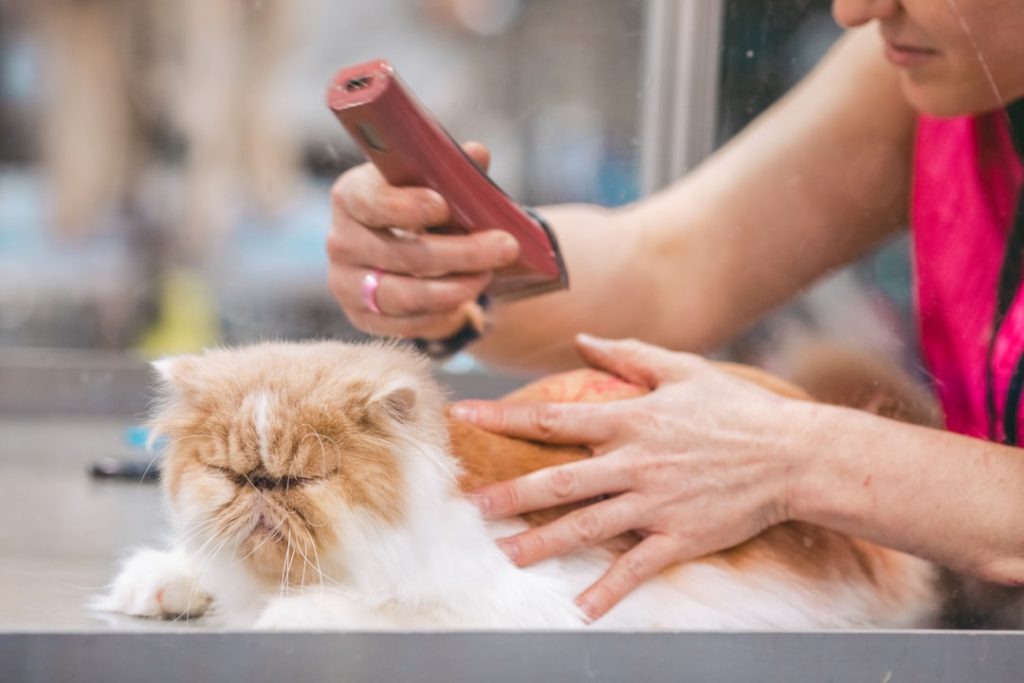If you have both dogs and cats at home, you might wonder if it’s okay to use your dog’s shampoo on your cat. After all, it seems easier to buy one product for both pets.
But is it really safe for your furry friend? Using the wrong shampoo can cause skin problems, discomfort, or even harm your cat’s health. You want what’s best for your pet, and that means understanding the differences between dog and cat shampoos.
Keep reading to find out why your cat needs special care and how you can keep them clean without risking their well-being.

Credit: pethealthpros.com
Differences Between Dog And Cat Skin
Understanding the differences between dog and cat skin is key when deciding if it’s safe to use dog shampoo on your cat. Their skin types vary in thickness, pH balance, and sensitivity. These differences affect how their skin reacts to different products, including shampoos.
Skin Thickness And Texture
Cat skin is generally thinner and more delicate than dog skin. This makes cats more prone to irritation from harsh ingredients. Dogs have thicker skin which can handle stronger cleansing agents better.
If you’ve ever noticed your cat scratching more after a bath, it might be due to this sensitivity. Are you sure your pet’s shampoo matches their skin’s needs?
Ph Balance Differences
The pH level of cat skin usually ranges from 6.0 to 7.0, which is more neutral. Dog skin tends to be slightly more alkaline, around 7.5 to 8.5. Using a shampoo designed for dogs on a cat can disrupt the cat’s skin pH.
This disruption can lead to dryness, itchiness, or even infections. You want to avoid upsetting your cat’s natural skin balance, right?
Sensitivity To Ingredients
Cats are more sensitive to certain chemicals and fragrances found in dog shampoos. Ingredients like tea tree oil, essential oils, or artificial dyes can cause allergic reactions in cats. Dogs tolerate these better due to their different skin properties.
Have you checked if your shampoo’s ingredients list is safe for cats? It might save your furry friend from discomfort.

Credit: pethealthpros.com
Common Ingredients In Dog Shampoo
Understanding the common ingredients in dog shampoo can help you decide if it’s safe to use on your cat. These shampoos often contain substances designed specifically for dogs, which might not always suit a cat’s sensitive skin or unique health needs.
Let’s look closely at what usually goes into dog shampoo and why these ingredients matter when considering your cat’s well-being.
Surfactants
Surfactants are the cleaning agents that help remove dirt and oils from your pet’s fur. They create the lather you see and feel during washing.
Common surfactants include sodium lauryl sulfate and sodium laureth sulfate. While effective for dogs, these can be harsh on cats, potentially causing irritation or dryness.
Fragrances And Perfumes
Many dog shampoos contain added scents to leave a fresh smell. These fragrances can be synthetic or natural.
Cats have a more sensitive sense of smell than dogs. Strong fragrances might overwhelm them or even cause allergic reactions. Have you noticed your cat avoiding certain scented products?
Antibacterial And Antifungal Agents
These ingredients help control infections or skin issues in dogs. Examples include chlorhexidine and benzoyl peroxide.
Such chemicals can be too strong for cats and may cause skin irritation or more serious health problems if absorbed. It’s important to know what’s safe for your cat’s delicate skin.
Conditioning Agents
Conditioners like aloe vera or oatmeal extract are added to soothe and moisturize the skin.
These ingredients are generally mild and beneficial, but their concentration and combination with other chemicals in dog shampoo might not suit cats perfectly.
Preservatives And Stabilizers
To keep shampoos fresh and effective, manufacturers add preservatives such as parabens or formaldehyde releasers.
Some of these can be harmful to cats, especially if ingested during grooming. Always check ingredient labels carefully before using any product on your cat.
Potential Risks For Cats
Using dog shampoo on cats might seem like a convenient choice, but it carries potential risks that you need to be aware of. Cats have different skin chemistry and sensitivities compared to dogs, so what works well for one may harm the other. Understanding these risks helps you protect your feline friend from discomfort and health issues.
Irritation And Allergic Reactions
Your cat’s skin is more sensitive than a dog’s. Dog shampoos often contain fragrances and ingredients that can cause itching, redness, or rashes in cats.
Even a mild reaction can stress your cat out. Imagine your cat scratching or grooming excessively because of discomfort. It’s not just unpleasant for them—it can lead to skin infections if untreated.
Have you noticed your cat avoiding baths or hiding afterward? This could be a sign of irritation from an unsuitable shampoo. Always watch closely for behavioral changes after bathing.
Toxic Ingredients To Avoid
Some dog shampoos include ingredients that are safe for dogs but toxic to cats. Ingredients like tea tree oil, essential oils, and certain insecticidescan cause serious harm.
Tea tree oil is a common culprit. Even small amounts can lead to symptoms like vomiting, weakness, or drooling in cats.
Here’s a quick list of toxic ingredients you should look out for:
- Tea tree oil
- Pyrethrin and permethrin (common in flea shampoos)
- Essential oils such as eucalyptus and lavender
- Phenols and coal tar derivatives
Do you check the ingredient list before buying pet products? This habit can save your cat from accidental poisoning.

Credit: www.reddit.com
Safe Alternatives For Cat Grooming
Choosing the right grooming products for cats is vital for their health and comfort. Cats have sensitive skin and different pH levels than dogs. Using dog shampoo can cause irritation or allergic reactions. Safe alternatives help keep your cat clean without risks. These options cater specifically to cats’ needs and ensure gentle care.
Cat-specific Shampoos
Cat-specific shampoos are designed with their delicate skin in mind. These shampoos balance the pH level suitable for cats. They avoid harsh chemicals that can cause dryness or itching. Many are formulated to control fleas and ticks safely. Some shampoos also soothe sensitive or irritated skin. Always choose products labeled for cats only. This ensures safety and effectiveness during grooming.
Homemade Cat-friendly Solutions
Homemade shampoos can be gentle alternatives for regular cleaning. Using natural ingredients reduces the risk of harmful reactions. Common ingredients include:
- Oatmeal, which calms itchy skin
- Water and mild baby shampoo, diluted to reduce strength
- A small amount of apple cider vinegar, which helps with odors
- Chamomile tea, known for soothing properties
Before applying any homemade solution, test a small area first. Watch for redness or discomfort. Homemade options are best for mild cleaning or spot treatments. They should not replace veterinary care for skin problems.
Vet Recommendations
Vet recommendations play a crucial role when considering whether to use dog shampoo on cats. Cats have different skin pH and sensitivities compared to dogs, so professional guidance helps you avoid harm. Understanding a vet’s advice empowers you to make safer choices for your pet’s grooming routine.
Seeking Professional Advice
Always ask your vet before using dog shampoo on your cat. They can suggest shampoos specifically formulated for cats or recommend safe alternatives. Vets also take into account your cat’s health history, allergies, and skin conditions, which you might not notice on your own.
During a visit, your vet might explain why certain ingredients in dog shampoo can irritate a cat’s skin or cause toxic reactions. Have you ever wondered if your cat’s scratching or redness could be linked to the products you use? Getting professional advice helps you prevent these problems before they start.
Signs Of A Bad Reaction
Knowing what to watch for after a bath is essential. If you see your cat scratching more than usual, developing redness, swelling, or hair loss, these are signs of a bad reaction. Sometimes, symptoms like vomiting or lethargy can also indicate a toxic response to the shampoo.
Quick action is key. If you notice any of these signs, rinse your cat thoroughly with water and contact your vet immediately. Have you ever experienced a pet reacting badly to a grooming product? Sharing your story with your vet can help them give you better advice tailored to your cat’s needs.
Best Practices For Bathing Cats
Bathing a cat can be a tricky task, but doing it right makes a huge difference in your cat’s comfort and safety. Cats are sensitive creatures, and their skin is different from dogs’. Understanding the best practices for bathing your feline friend helps avoid stress and keeps their coat healthy.
Preparing The Bath Environment
Choose a small, quiet room where you won’t be interrupted. This limits escape routes and keeps your cat from getting overly anxious. Lay down a non-slip mat or towel in the sink or tub to prevent slipping.
Gather everything before you start: cat-safe shampoo, a cup for rinsing, a soft towel, and treats for rewarding good behavior. Warm water—not hot or cold—is essential to keep your cat comfortable. Think about the lighting too; a well-lit room helps you see if the shampoo is fully rinsed out.
Proper Bathing Techniques
Start by gently wetting your cat’s coat with lukewarm water, avoiding the face and ears. Use a cat-specific shampoo because dog shampoos can irritate a cat’s skin or disrupt their natural oils. Massage the shampoo in gently, making sure to cover the body without causing distress.
Rinse thoroughly with clean water to remove all shampoo residue. Leftover shampoo can cause itching or dryness. Use a towel to pat your cat dry immediately after the bath and keep them warm until fully dry.
Have you noticed how your cat reacts when you rush or force the bath? Moving slowly and calmly can turn a stressful event into a manageable one. Remember, patience is key to a smoother experience for both you and your cat.
Maintaining Cat’s Skin Health
Keeping your cat’s skin healthy is key to their comfort and overall well-being. Cats have sensitive skin that can easily become dry, irritated, or infected if not cared for properly. Understanding how to maintain their skin health helps you avoid common problems and ensures your furry friend stays happy and itch-free.
Regular Grooming Routines
Regular grooming is more than just keeping your cat looking good—it’s essential for skin health. Brushing removes loose fur and dirt, which helps prevent clogged pores and reduces the risk of skin infections. It also stimulates natural oils, keeping the skin moisturized and shiny.
Try to groom your cat at least a few times a week, especially if they have long hair. Notice any flakes, redness, or bumps during grooming—these signs can point to skin problems that need attention. How often do you check your cat’s skin while grooming?
Diet And Hydration Impact
Your cat’s diet directly affects their skin condition. Foods rich in omega-3 and omega-6 fatty acids support healthy skin and reduce inflammation. You can find these in certain fish oils or specially formulated cat foods.
Hydration matters just as much. Cats often don’t drink enough water, which can lead to dry, flaky skin. Encourage water intake by offering wet food or fresh water regularly. Could improving your cat’s diet and water routine be the missing piece in their skin care?
Frequently Asked Questions
Can I Use Dog Shampoo Safely On My Cat?
No, dog shampoo is not safe for cats. Cats have sensitive skin and different pH levels. Using dog shampoo can cause irritation and allergic reactions. Always use a shampoo formulated specifically for cats to ensure their safety and skin health.
What Are The Risks Of Using Dog Shampoo On Cats?
Using dog shampoo on cats can cause skin dryness, itching, and allergic reactions. Some ingredients in dog shampoo are toxic to cats. It may also affect their fur texture and overall skin health. Avoid dog shampoos to keep your cat safe and comfortable.
How Is Cat Shampoo Different From Dog Shampoo?
Cat shampoos are formulated with milder ingredients tailored for feline skin. Cats have more sensitive skin and a different pH balance than dogs. Cat shampoos avoid harmful chemicals found in some dog shampoos. This ensures gentle cleaning without causing irritation or harm.
What Should I Do If I Accidentally Use Dog Shampoo On My Cat?
If you accidentally use dog shampoo, rinse your cat immediately with lukewarm water. Watch for signs of irritation, like redness or excessive scratching. Contact your veterinarian if symptoms persist or worsen. Prompt action can prevent serious skin problems or toxic reactions.
Conclusion
Using dog shampoo on cats can cause skin problems. Cats have different skin and fur needs than dogs. Some ingredients in dog shampoo may harm cats. Always choose shampoos made specifically for cats. If unsure, ask your vet for advice.
Keeping your cat safe and healthy matters most. Proper care helps your pet stay happy. Avoid risks by using the right products. Simple steps protect your feline friend well. Safe grooming keeps cats clean and comfortable.

Emily Barker is the founder of ChillDogLife.com, a space dedicated to helping pup parents discover the best dog products, lifestyle tips, and cozy ideas for happier homes.
A lifelong dog lover, Emily combines her passion for pets with a knack for research to share trusted recommendations on everything from toys and furniture to health and everyday care.
Her goal is simple: to make life easier, stylish, and more joyful for dogs and the people who love them.







